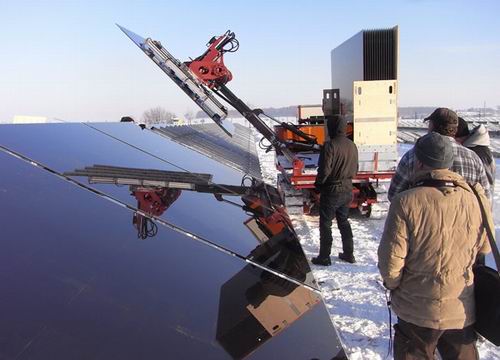As the price of solar panels has plummeted, the global amount of solar power is now rising upwards. In spite of this, solar energy still accounts for less than 2% of the world's total generating capacity. This is not surprising. The power generated per square meter of solar panels is about 145 watts, which can light only two or three bulbs. This means that if the benefits of solar power are comparable to the peak capacity of a large fossil-fuel power plant, solar panels will have to be covered in an area equivalent to 5 to 6 major national plazas like Washington, DC. More importantly, so many panels are each manually installed. At present, some German companies, such as PV Kraftwerker and Gehrlicher, are developing mobile robots capable of automatically installing ground-mounted solar panels under various weather conditions day and night. The robot designed by PV Kraftwerker is expected to be able to assemble power plant-level solar panels, which are four times larger than the home roof panels. The main purpose of developing such robots is to save labor costs, because as the price of panels decreases, the proportion of labor costs in solar power generation will increase. According to PV Kraftwerker, a solar park construction company, the previous installation required 35 workers to complete the installation. Now it only takes 3 and only 1/8 of the time is spent. The company estimates that for a solar power plant with an energy generation level of 14 megawatts, the cost of manually installing panels will be approximately $2 million. If this work is done by robots, the cost can be reduced by nearly half. The company also said that the robot, which is priced at $900,000, will continue to be used for less than a year and will be able to recover its cost. Germany is currently planning ambitiously to achieve one-third of the country's electricity from renewable sources in 8 years and increase to 80% by 2050. With this in mind, the help of robots will facilitate the realization of these goals (see "German Energy Experiment"). In 2011, Germany had the world's leading installed capacity for solar energy. A total of about 7.5 GW of electricity was installed in the year to cover almost 50 square kilometers of ground and roof. PV Kraftwerker builds robots using ready-made components from Japan. Its robotic arm rests on an all-terrain vehicle with a similar tank track. After the suction cup grasps the glass surface of the panel, the robot arm will place the panel in the correct position according to the on-site three-dimensional view guidance provided by the camera. The limitations of robots also make it very difficult to fully automate the installation process. Most of the solar power in Germany comes from solar arrays on the roof, but due to too many changes in the shape and orientation of the roof, it is more difficult to install the robot. What's more, Markus Gattenlöhner, marketing director at PV Kraftwerker, says that even with the solar cells that use normal-sized panels in small solar farms, human workers work faster and at lower cost than robots. Christian Hoepfner, scientific director of the Fraunhofer Center for Sustainable Energy Systems (see Redesigning Solar Power), also believes that the role of robots will be limited. "But for large, ground-mounted installations, I can see their benefits," he said. "When you want to cover a large area with the same panel, you naturally think so, 'Why not let the robots install these things?' As the size of the installation increases, the use of robots is inevitable." ." So far, the robot developed by PV Kraftwerker can only do one thing: Put the panel on the metal rack that humans have already installed. It also requires two workers to walk next to the robot, fix the panel on the metal frame with screws, and connect the circuit. However, as other components of the robot become increasingly automated, the use of robots during the installation process may become more and more common. Now, PVKraftwerker and other companies of the same type are also developing another type of robot. Under the guidance of the Global Positioning System (GPS), they can drill holes in the ground and then install the panels inside, so there is no need for Human workers came to install metal racks. Some of the newer solar cell components do not need human screws, and can be "scratched" or stuck in position. Special plugs can even allow robots to make circuit connections (see "New designs for solar panels, making installation cheaper New Solar Panel Designs Make Installation Cheaper"). These robots can provide electricity in harsh environments. The Japanese government has commissioned PV Kraftwerker to develop a domestic machine-installing worker. They will be able to install a solar power plant in an area that has been exposed to radiation near the disaster site of the Fukushima nuclear power plant. Gattenlöhner said that the Japanese government hopes to receive these robots within six months. New design ceiling fan,ceiling fan with light,decorative ceiling fan JIANGMEN ESCLIGHTING TECHNOLOGY LIMITED , https://www.windfansummer.com
Sustainable robots: In the vicinity of Leipzig, Germany, the robot arm is mounting a large photovoltaic panel on a shelf.